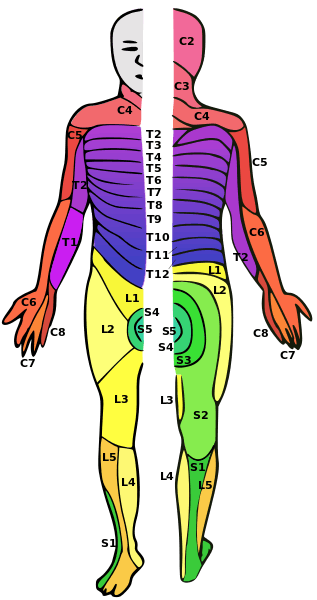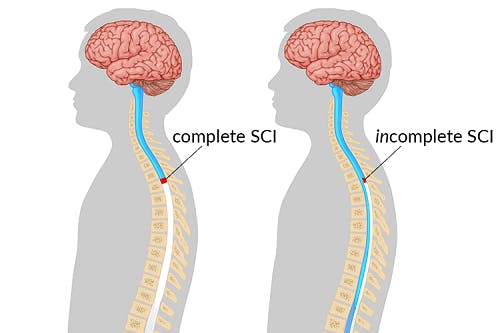A lumbar spinal cord injury can cause varying degrees of paralysis in the lower body, also known as paraplegia. With effective management strategies, individuals with lumbar spinal cord injuries can maximize their functional abilities and lead fulfilling lives.
To help you understand what to expect after a lumbar spinal cord injury, this article will discuss:
- Definition
- Functions Affected
- Complete vs. Incomplete Lumbar SCI
- Potential Complications
- Recovery Methods
What is a Lumbar Spinal Cord Injury?
The lumbar region of the spinal cord consists of 5 segments, based on the five lumbar vertebrae. Each segment connects to a different area of skin for sensation and muscles for movement. When the spinal cord is partially or completely severed in this area, it is referred to as a lumbar spinal cord injury.
Traumatic lumbar spinal cord injuries are caused by an external force, such as a car accident, fall, or violence. In contrast, non-traumatic causes of lumbar spinal cord injury include tumor/cancer, infection, autoimmune disease, herniated disc/spinal stenosis, or a vascular event such as a spinal stroke.
Damage to the lumbar spinal cord can affect motor and sensory functions at and below the level of injury, while functions above the level of injury remain intact. Therefore, most individuals who have sustained a lumbar spinal cord injury experience sensory and/or motor deficits in their lower body, but can use their upper body and trunk normally.
Functions Affected by Lumbar Spinal Cord Injury

Medical professionals often use the International Standards for Neurological Classification to determine the level of spinal cord injury. This involves testing sensation and motor functions in various areas of the body.
Because messages between the brain and body cannot pass through spinal cord damage, motor functions and sensation at and below the level of injury may be impaired.
Therefore, it helps to understand which functions are affected by all other types of spinal cord injury below your level of injury. For example, if you sustain an L2 spinal cord injury, it helps to understand what is affected in an L3-L5 SCI as well.
The following list explains which functions may be affected at each level of lumbar spinal cord injury:
L1 Spinal Cord Injury
L1 spinal nerves affect movement and sensation of the pelvic/hip region and below. Therefore, when a lumbar spinal cord injury at this level occurs, it can affect bowel and/or bladder function.
L2 Spinal Cord Injury
L2 spinal nerves affect sensation in the front portion of the upper thighs. The muscles involved in bending the hips (hip flexors) and bringing the legs together (hip adductors) are also connected to the spinal cord at this level. Thus, individuals with an L2 spinal cord injury may struggle with moving their legs and hips, along with symptoms similar to an L1 injury.
L3 Spinal Cord Injury
L3 spinal nerves affect sensation at the front portion of the lower thighs and knees, as well as the ability to straighten the knees (knee extension) and rotate the hip outward (external rotation). A lumbar spinal cord injury at this level will therefore affect the ability to move the lower legs.
L4 Spinal Cord Injury
L4 spinal nerves affect sensation at the front and inner regions of the lower legs. The ability to lift the foot upwards (ankle dorsiflexion) is primarily tested to determine whether this level of the spinal cord has been injured.
However, many other motor functions are also innervated at this level. Hip functions affected by the L4 spinal nerves include the ability to bring the leg back (hip extension), pull the leg outward (hip abduction), and rotate the hip inward (internal rotation). Bending of the knee (knee flexion), side to side movement of the ankle (inversion and eversion), as well as straightening of the toes (toe extension) are also controlled by the spinal cord injury nerves at this level.
L5 Spinal Cord Injury
L5 spinal nerves affect sensation at the outer areas of the lower legs down to the big, second, and middle toes. The ability to bend and straighten the big toe (flexion and extension) and the ability to separate the toes (abduction) is also affected at this level. Therefore, a lumbar spinal cord injury at this level is likely to affect feeling and movement in the feet.
Complete vs. Incomplete Lumbar Spinal Cord Injury

Even individuals with the same level of injury may experience different secondary effects depending on the severity of injury. While individuals with complete spinal cord injuries lose all motor control and feeling below their level of injury, those with incomplete spinal cord injuries will retain partial motor control and/or sensation below the level of injury.
In a complete spinal cord injury, the spinal cord is completely severed, leaving no spared neural pathways. This eliminates all pathways for communication between the brain and areas below the level of injury.
When the spinal cord is only partially severed, as occurs in an incomplete spinal cord injury, some neural pathways remain undamaged. Therefore, connections between areas below the level of injury and the brain still exist.
These spared neural pathways play an essential role in the recovery of lumbar spinal cord injuries (and all other SCIs). Since damaged neurons (nerve cells) in the spinal cord are not capable of regeneration, only spared neural pathways can be adapted and rewired through a process called neuroplasticity. Neuroplasticity allows spared neural pathways in the spinal cord to compensate for the pathways that were damaged.
In turn, this allows individuals to relearn functions after an incomplete spinal cord injury. There must be spared neural pathways in order for this to occur, so the more spared neural pathways that exist, the higher your potential for recovery.
Potential Complications of Lumbar Spinal Cord Injury
No two spinal cord injuries are alike and individuals can experience a wide range of secondary complications. Generally, more severe spinal cord injuries carry a greater risk of complications.
Some potential complications following a lumbar spinal cord injury include:
- Spasticity: involuntary muscle contractions that can cause stiff movements, muscle tightening and spasms
- Neurogenic bowel and bladder: loss of control over the bowel and bladder muscles that can increase the risk of leaking, constipation, and urinary retention
- Sexual dysfunction: impaired sexual functions due to the injury impeding the reflexes involved in sexual arousal. Loss of sensation and lack of lower body mobility also play a role in impaired sexual functioning
- Chronic pain: pain can be the result of overdependence on unaffected areas (i.e over-reliance on shoulders for wheelchair mobility), bowel and bladder problems, or nerve damage
- Muscle atrophy: reduced physical activity and limited weight-bearing can cause the leg muscles to weaken and shrink
- Pressure sores: sitting or lying in the same position for prolonged periods places too much pressure on the skin, causing inflammation and breakdown over time
In the following section, we’ll discuss how to manage complications and promote recovery after a lumbar spinal cord injury.
Lumbar Spinal Cord Injury Recovery
Recovery outcomes following a lumbar spinal cord injury vary depending on the level and severity of the injury. With proper treatment and management techniques, many individuals are able to participate in most of their day-to-day activities with minimal or no difficulty.
Unless other medical complications are present, individuals with lumbar spinal cord injuries have normal functioning of their upper bodies. Therefore, many individuals learn to use their upper body to compensate for deficits in sensation and movement of their lower body.
Methods to help you improve and embrace life after lumbar spinal cord injury include:
Rehabilitative Therapies
Physical therapy uses targeted exercises to improve mobility, strength, and flexibility, while occupational therapy focuses on regaining independence in daily activities. Occupational therapists may encourage using adaptive techniques as necessary.
Medical Equipment
Common types of medical equipment for lumbar spinal cord injury include:
- Orthotics: wearable devices to promote musculoskeletal alignment
- Mobility devices: wheelchairs, walkers, canes, etc.
- Adaptive equipment: tools to assist with daily activities, such as a leg lifter
- Other medical equipment: shower chairs, raised toilet seats, etc.
- Car adaptations: such as hand controls or wheelchair locking mechanisms
- Exoskeletons: robotic exoskeletons are currently being studied, but show promising results for allowing individuals with complete lumbar spinal cord injuries to walk again
Talk with your doctor or therapist about what equipment may be beneficial for you.
Emotional Support
The emotional effects of a lumbar spinal cord injury can be as challenging as the physical effects. Joining a SCI support group can help you connect with others who understand what you’re going through. For more individualized care, psychotherapy may be used to help you cope with the secondary effects of your injury.
Medical Interventions
Medications may be prescribed to help manage secondary complications such as pain, constipation, and spasticity. Additionally, surgery may be recommended for some individuals to decompress the spinal cord, stabilize the spinal column, manually lengthen spastic tendons and muscles, and minimize the hyperactivity of spastic muscles.
Lifestyle Adaptations
Creating a routine can encourage consistency with your exercises and medications. It can also help you better predict your bladder and bowel movements. Although improvements are possible, embracing your current abilities and engaging in activities you value is important at all stages of recovery.
Thanks to the Americans with Disabilities Act, most restaurants, stores, and other public places are wheelchair accessible. For those who are used to being more active, many areas have adaptive sports, and rentals for off-roading track chairs are becoming more popular.
By learning how to maximize functional abilities, individuals with lumbar spinal cord injuries can achieve a good quality of life and pursue engaged, active lifestyles.
Understanding Lumbar SCI
Lumbar spinal cord injuries can affect movement and sensation in the lower body. However, because lumbar SCI’s do not affect upper body functions, individuals generally learn to adapt and live independent, fulfilling lives. Hopefully this article helped you understand what to expect following a lumbar spinal cord injury and how to promote recovery.
The post Lumbar Spinal Cord Injury: What to Expect After L1, L2, L3, L4, L5 SCI appeared first on Flint Rehab.



